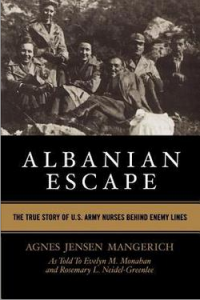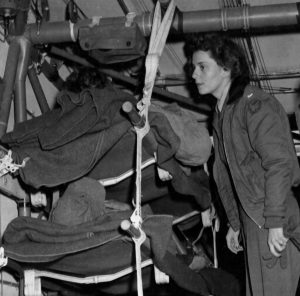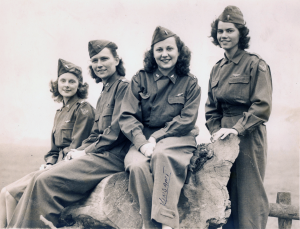Second in a Series of Ten Blogs offering A Short History of Nursing from antiquity through the mid-twentieth century. Part 1 – From Sacred to Secular – covers nursing in ancient times through the Crimean War. Part 2 – From Civilian to Military – continues with the establishment of the Saint Thomas School of Nursing through World War II.
A Short History of Nursing
Through World War II
Part 1 From Sacred to Secular Nurses
Religious Orders and Deaconesses
The Augustinian Sisters, the first nursing order, staffed the charitable Hotel Dieu hospital in Paris, founded around 650 A.D. The nuns’ work included admission, discharge, and burial of patients, as well as kitchen and laundry duties. 1 The Sisters’ nursing care is both notable and notorious, for these nuns took their orders from their ecclesiastical superiors, not from the medical men, leading the hospital’s governors to accuse them of having more interest in prayer and meditation than in patient welfare – unless, perhaps, it was a matter of their patients’ religious health. 2
The non-cloistered Sisters of Charity founded by parish priest Vincent de Paul in seventeenth-century France, marked an important development in nursing by shifting the model of the pious woman into a public life of service to the sick poor – defined as much by pragmatism as by prayer. “The fame of the Sisters of Charity reached an all-time high in the early nineteenth century, as they were recruited into the French army during the Napoleonic Wars, establishing the path-breaking entrance of women into military nursing,” note Lavinia Dock and Isabel Stewart. 3
Aspects of the Catholic nursing orders found their way into Protestant countries when, after Henry VIII closed most of the monastic hospitals in the sixteenth century, he granted endowments to reopen some of them including Saint Bartholomew’s and Saint Thomas in London. These hospitals had female attendants originally referred to as sisters, according to the monastic custom; a list of sisters at Saint Bartholomew’s first appears in 1553. Over time, the term referred more specifically to the person in charge of a ward, and those under her supervision were called nurses. By 1771 Saint Bartholomew’s had around a hundred women on staff in a hierarchy of nursing positions from matron in charge of the hospital through sisters, nurses, helpers, and watchers – the forerunner of the night nurse. 4
When Pastor Theodore Fliedner began his work with the Protestant congregation in the overwhelmingly Catholic German village of Kaiserwerth in the 1820s, he encountered an area hit hard economically by early industrialization and much in need of social welfare; the training of Protestant deaconesses for teaching and for nursing the sick poor was begun to address the situation. 5 From its inception, the Kaiserwerth Deaconess Institute stood apart from other religious organizations for women in “identifying the need for theoretical and practical training as central to its mission.” 6 Fliedner envisioned that the deaconess nurses would treat people, not diseases, thus establishing the concept of care, not cure as the trained nurses’ domain to justify it as a separate profession from medicine. 7
The innovative training program conducted within a patriarchal family setting that drew on useful aspects of a religious sisterhood such as a Protestant motherhouse and use of “Sister” as a form of address, helped assuage social anxieties that had arisen from the need to create a place for the “surplus” single young women of all classes without marital prospects or familial support whose lives had been upended by the changing economy. “The acknowledgment that institutions like Kaiserswerth, founded under the guise of Christian piety and service, could remedy such a social problem enhanced its reputation” and, as Catherine Prelinger notes, enabled the Institute successfully to “weather the storms of economic and social upheaval during the industrialization process – a transition that was thought to have hit middle- and upper-class women particularly hard.” 8
Religious devotion more than social standing determined a woman’s suitability to enter the program, whether from the upper, middle, or working class. The Institute’s myth of nursing as a respectable employment for women was so powerful that, according to Aeleah HeaRan Soine, “it became something of a self-fulfilling prophecy,” and “after only a few decades, deaconess nursing had become not only suitable for respectable women, but actually had become a conveyor of respectability itself.” 9
The Kaiserwerth Deaconess Institute set the standard for nursing reform and training that began in nineteenth-century England. It was, Sarah Tooley writes, “the parent of all Protestant nursing institutions, and it is impossible to over-estimate its influence on the early growth of nursing.” 10 Elizabeth Fry, who visited Kaiserwerth, took away some of its principles for her Protestant Sisters of Charity, renamed Institute of Nursing Sisters, founded in London in 1840. After three months of training at teaching hospitals, Fry’s working-class nurses made home visits to the sick poor. Florence Nightingale, who visited the Kaiserwerth Deaconess Institute in 1850 and returned for three months of training in 1851, applied some of Fliedner’s values and organizational structure to her own training program for nurses established at Saint Thomas Hospital in 1860.
To learn how the history of nursing was reflected on the opera stage, see Judith Barger, The Nurse in History and Opera: From Servant to Sister (Lexington Books, 2024).
Notes
- M. Patricia Donahue, Nursing, the Finest Art: An Illustrated History (St. Louis: Mosby, 1985), 136.
- Robinson, White Caps, 54.
- Lavinia L. Dock and Isabel Maitland Stewart, A Short History of Nursing from the Earliest Times to the Present Day (New York: Putnam, 1920), 101.
- Vern L. Bullough and Bonnie Bullough, The Emergence of Modern Nursing, 2nd ed. (London: Collier-Macmillan, 1969), 65.
- Aeleah HeaRan Soine, “From Nursing Sisters to a Sisterhood of Nursing: German Nurses and Transnational Professionalization, 1836–1918” (Ph.D. diss., University of Minnesota, 2009), 25–26, 29.
- Ibid., 30.
- Catherine M. Prelinger, Charity, Challenge, and Change: Religious Dimensions of the Mid-Nineteenth-Century Women’s Movement in Germany (New York: Greenwood, 1987), 20; Soine, “From Nursing Sisters to a Sisterhood of Nursing,” 29.
- Soine, “From Nursing Sisters to a Sisterhood of Nursing,” 40; Catherine Prelinger, “The Nineteenth-century Deaconessate in Germany: The Efficacy of a Family Model,” in German Women in the Eighteenth and Nineteenth Centuries, ed. Ruth-Ellen Joeres and Mary Jo Maynes (Bloomington: Indiana University Press, 1986), 215–16.
- Soine, “From Nursing Sisters to a Sisterhood of Nursing,” 53–59, 63, 66.
- Sarah A. Tooley, A History of Nursing in the British Empire (London: Bousfield, 1906), 27.
Featured Image:
the-australian-national-maritime-museum-9cHrXOvbj38-unsplash.jpg



